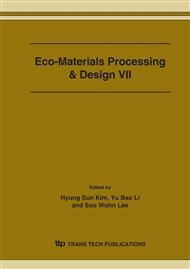p.298
p.302
p.306
p.310
p.314
p.318
p.322
p.326
p.330
Preparation and Characterization of Chemical Activated Fibers on Various Carbon Fibers
Abstract:
OXI-PAN fibers, Kynol fibers, and rayon fibers were used as precursors for the preparation of activated carbon fibers (ACFs) by chemical activation with KOH at 800°C. The effects of different precursor fibers and fiber/KOH ratios on the final ACFs are discussed. The precursor fibers used were appropriate for the ACFs in a single stage pyrolysis process. The OXI-PAN fibers, which were activated with KOH of 2.0M, showed a specific surface area of 2328m2/g, however, lost the fiber shape because of low yields. The Kynol fibers and Rayon fibers showed the high yields, but lower specific surface areas of 900m2/g and 774m2/g, respectively, at KOH of 1.5M. The OXI-PAN fibers, which were activated with KOH of 1.5M, have a specific surface area of 1028m2/g and higher micro-pore volumes and lower yields rather than Kynol-1.5 and Rayon-1.5 samples. This phenomenon is attributed to higher chemical resistance of the Kynol and Rayon fibers rather than OXI-PAN fibers. However, the Kynol fibers were the best precursors on KOH activation at 800°C when carbon yields, surface areas, and micropore volumes are condisered.
Info:
Periodical:
Pages:
314-317
Citation:
Online since:
March 2006
Authors:
Price:
Сopyright:
© 2006 Trans Tech Publications Ltd. All Rights Reserved
Share:
Citation:


